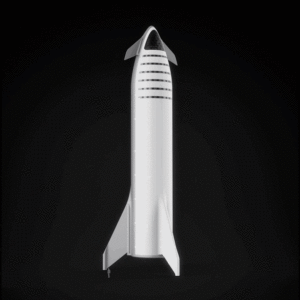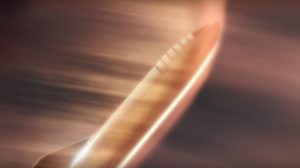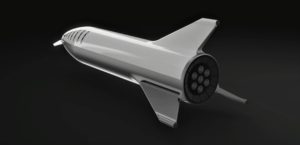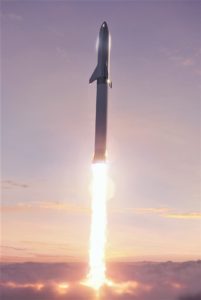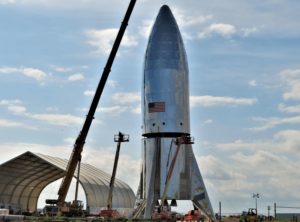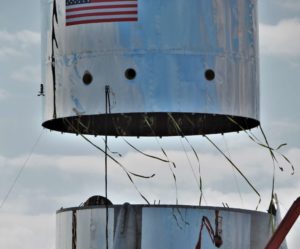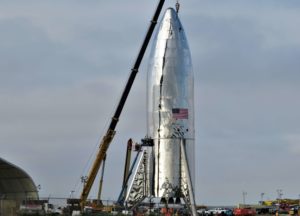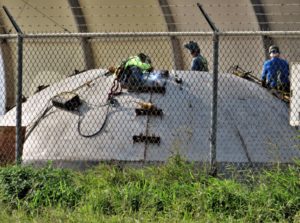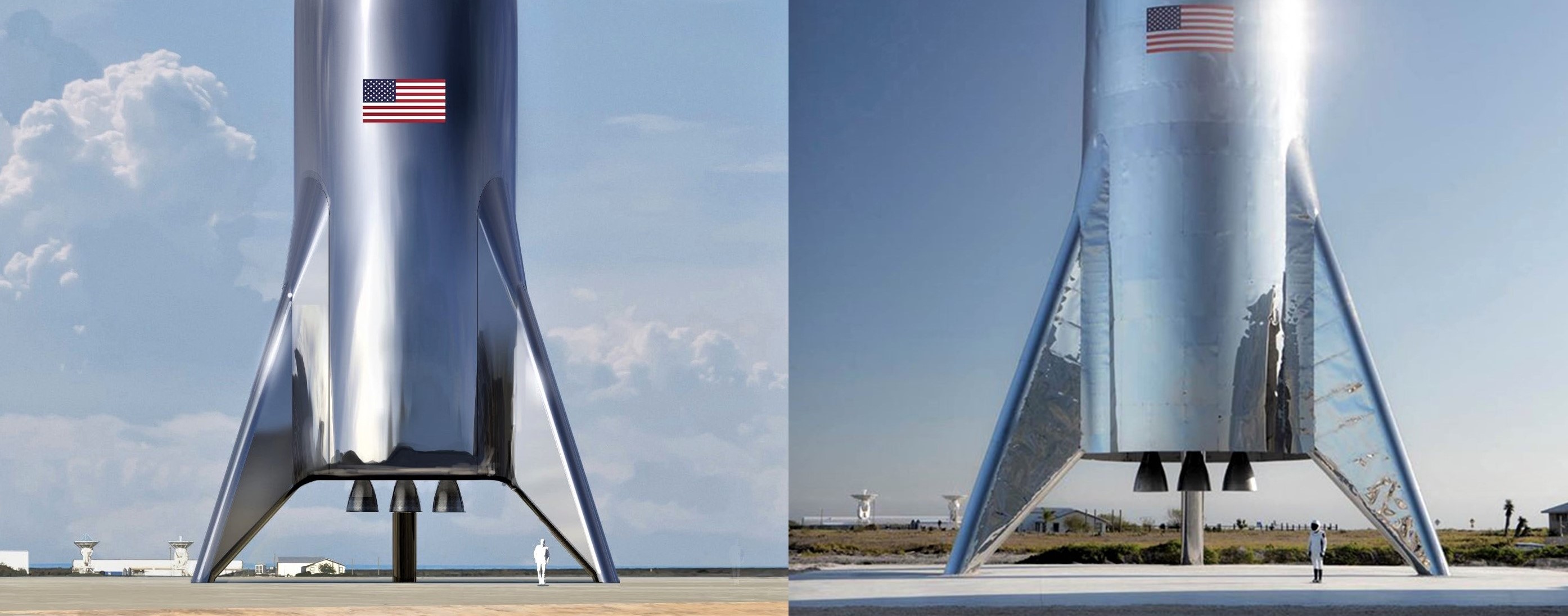

News
SpaceX CEO Elon Musk says first orbital Starship prototype will be done by June
SpaceX CEO Elon Musk says that the company’s first Starship prototype – a low-fidelity hop test vehicle – has finished assembly in South Texas, paving the way towards a series of experimental vertical take-off or landing (VTOL) hop tests that could begin as early as February or March 2019.
One step beyond the prototype currently rising out of the coastal Texas wetlands, Musk also indicated that the first orbital Starship prototype – essentially the spacecraft’s first full-fidelity test article – could be completed as early as June 2019, a truly extraordinary pace of development for a program as complex and cutting-edge as BFR.
Starship test flight rocket just finished assembly at the @SpaceX Texas launch site. This is an actual picture, not a rendering. pic.twitter.com/k1HkueoXaz
— Elon Musk (@elonmusk) January 11, 2019
Starhopper rising
Barely six weeks after work began on the massive Starship prototype, SpaceX’s Starhopper appears to have grown to its full ~40m (~130 ft) height in South Texas. Following a preliminary fit test on Tuesday, January 8th, workers made a second attempt on Wednesday and completed the final attachment of Starhopper’s upper and lower halves. Intriguingly, no time was wasted spot-welding the halves together after their successful docking, and an additional sheet of stainless steel has been welded over the seam in the hours since then.
- It remains to be seen if BFR can be made as reusable and reliable as it will need to be to sustainably support interplanetary humans. (SpaceX)
- Eventually, SpaceX may graduate into high-speed, high-altitude flight tests of the prototype spaceship to fully test the design of its its control surfaces and “ultra-lightweight heat shield”. (SpaceX)
- (SpaceX)
- BFR’s booster, now known as Super Heavy. (SpaceX)
- BFR (2018) breaks through a cloud layer shortly after launch. (SpaceX)
However, what looks like 9m-diameter (~30 ft) steel tank domes are being assembled and welded together at the same SpaceX facility, despite the fact that no domes have been observed being installed inside Starhopper. Musk did seem to indicate that even Starhopper – requiring far less propellant than an orbital Starship – will still feature full 9m (~30 foot) diameter tanks. This could imply that the newly integrated Starhopper has yet to have propellant tank domes installed inside and will need to be taken apart again to allow for that critical final step. If that is not the case, the only possible explanation is that Starhopper’s propellant tanks will actually be less than 9m in diameter and will be lifted up through the vehicle’s aft for installation.
One last increasingly improbable possibility is that a significant portion of the hopper’s upper half will be or already is a pressure vessel capable of holding cryogenic propellant, although the process of actually watching the less than surgical fabrication does not inspire a great deal of confidence in any potential pressure vessel aspirations. In the meantime, we have been given the first look at what the outside of Starhopper will look like once complete. According to SpaceX CEO Elon Musk, hop tests of the imposing vehicle could begin as few as 4-8 weeks from now.
- Starhopper is assembled for the second time, January 9th. (NSF – bocachicagal)
- And voila! (NSF – bocachicagal)
- Meanwhile, giant 9m-diameter tank domes are being assembled and welded together a few hundred feet away from Starhopper. (NSF – bocachicagal)
To orbit, and beyond!
Aside from offering the above photo and comparing Starhopper’s prospects to those of Falcon 9’s Grasshopper and F9R hop test articles (i.e. very suborbital and very short-lived), Musk also stated that the first orbital Starship prototype could be completed as early as June 2019, as few as three months after Starhopper’s first hop test. This paints at least a rough picture of the planning going on for BFR’s flight test regime, beginning with a suborbital hop test prototype, moving to a full-fidelity Starship capable of high-speed intra-atmospheric heat shield and aero surface testing, and finally full-up orbital testing with the completion of the first BFR booster (now known as Super Heavy).
Should be done with first orbital prototype around June
— Elon Musk (@elonmusk) January 11, 2019
Both, but demo Starship is being built now, whereas Super Heavy hardware will start getting built in spring
— Elon Musk (@elonmusk) December 9, 2018
According to Musk, the first Super Heavy booster will begin production and assembly as early as spring 2019, while the CEO stated that he believed the odds of BFR (Starship/Super Heavy) reaching orbit by 2020 were 60% and “growing rapidly” thanks to a recent move from carbon composite tankage to stainless steel. If SpaceX and Musk keep putting their money where their mouths are and rapidly building test articles and prototypes, that orbital debut might actually be less insane than it sounds. We’ll find out soon enough.
For prompt updates, on-the-ground perspectives, and unique glimpses of SpaceX’s rocket recovery fleet check out our brand new LaunchPad and LandingZone newsletters!
Elon Musk
Tesla reveals it is using AI to make factories more sustainable: here’s how
Tesla is using AI in its Gigafactory Nevada factory to improve HVAC efficiency.

Tesla has revealed in its Extended Impact Report for 2024 that it is using Artificial Intelligence (AI) to enable its factories to be more sustainable. One example it used was its achievement of managing “the majority of the HVAC infrastructure at Gigafactory Nevada is now AI-controlled” last year.
In a commitment to becoming more efficient and making its production as eco-friendly as possible, Tesla has been working for years to find solutions to reduce energy consumption in its factories.
For example, in 2023, Tesla implemented optimization controls in the plastics and paint shops located at Gigafactory Texas, which increased the efficiency of natural gas consumption. Tesla plans to phase out natural gas use across its factories eventually, but for now, it prioritizes work to reduce emissions from that energy source specifically.
It also uses Hygrometric Control Logic for Air Handling Units at Giafactory Berlin, resulting in 17,000 MWh in energy savings each year. At Gigafactory Nevada, Tesla saves 9.5 GWh of energy through the use of N-Methylpyrrolidone refineries when extracting critical raw material.
Perhaps the most interesting way Tesla is conserving energy is through the use of AI at Gigafactory Nevada, as it describes its use of AI to reduce energy demand:
“In 2023, AI Control for HVAC was expanded from Nevada and Texas to now include our Berlin-Brandenburg and Fremont factories. AI Control policy enables HVAC systems within each factory to work together to process sensor data, model factory dynamics, and apply control actions that safely minimize the energy required to support production. In 2024, this system achieved two milestones: the majority of HVAC infrastructure at Gigafactory Nevada is now AI-controlled, reducing fan and thermal energy demand; and the AI algorithm was extended to manage entire chiller plants, creating a closed-loop control system that optimizes both chilled water consumption and the energy required for its generation, all while maintaining factory conditions.”
Tesla utilizes AI Control “primarily on systems that heat or cool critical factory production spaces and equipment.” AI Control communicates with the preexisting standard control logic of each system, and any issues can be resolved by quickly reverting back to standard control. There were none in 2024.
Tesla says that it is utilizing AI to drive impact at its factories, and it has proven to be a valuable tool in reducing energy consumption at one of its facilities.
Elon Musk
Tesla analysts believe Musk and Trump feud will pass
Tesla CEO Elon Musk and U.S. President Donald Trump’s feud shall pass, several bulls say.

Tesla analysts are breaking down the current feud between CEO Elon Musk and U.S. President Donald Trump, as the two continue to disagree on the “Big Beautiful Bill” and its impact on the country’s national debt.
Musk, who headed the Department of Government Efficiency (DOGE) under the Trump Administration, left his post in May. Soon thereafter, he and President Trump entered a very public and verbal disagreement, where things turned sour. They reconciled to an extent, and things seemed to be in the past.
However, the second disagreement between the two started on Monday, as Musk continued to push back on the “Big Beautiful Bill” that the Trump administration is attempting to sign into law. It would, by Musk’s estimation, increase spending and reverse the work DOGE did to trim the deficit.
Every member of Congress who campaigned on reducing government spending and then immediately voted for the biggest debt increase in history should hang their head in shame!
And they will lose their primary next year if it is the last thing I do on this Earth.
— Elon Musk (@elonmusk) June 30, 2025
President Trump has hinted that DOGE could be “the monster” that “eats Elon,” threatening to end the subsidies that SpaceX and Tesla receive. Musk has not been opposed to ending government subsidies for companies, including his own, as long as they are all abolished.
How Tesla could benefit from the ‘Big Beautiful Bill’ that axes EV subsidies
Despite this contentious back-and-forth between the two, analysts are sharing their opinions now, and a few of the more bullish Tesla observers are convinced that this feud will pass, Trump and Musk will resolve their differences as they have before, and things will return to normal.
ARK Invest’s Cathie Wood said this morning that the feud between Musk and Trump is another example of “this too shall pass:”
BREAKING: CATHIE WOOD SAYS — ELON AND TRUMP FEUD “WILL PASS” 👀 $TSLA
She remains bullish ! pic.twitter.com/w5rW2gfCkx
— TheSonOfWalkley (@TheSonOfWalkley) July 1, 2025
Additionally, Wedbush’s Dan Ives, in a note to investors this morning, said that the situation “will settle:”
“We believe this situation will settle and at the end of the day Musk needs Trump and Trump needs Musk given the AI Arms Race going on between the US and China. The jabs between Musk and Trump will continue as the Budget rolls through Congress but Tesla investors want Musk to focus on driving Tesla and stop this political angle…which has turned into a life of its own in a roller coaster ride since the November elections.”
Tesla shares are down about 5 percent at 3:10 p.m. on the East Coast.
Elon Musk
Tesla scrambles after Musk sidekick exit, CEO takes over sales
Tesla CEO Elon Musk is reportedly overseeing sales in North America and Europe, Bloomberg reports.

Tesla scrambled its executives around following the exit of CEO Elon Musk’s sidekick last week, Omead Afshar. Afshar was relieved of his duties as Head of Sales for both North America and Europe.
Bloomberg is reporting that Musk is now overseeing both regions for sales, according to sources familiar with the matter. Afshar left the company last week, likely due to slow sales in both markets, ending a seven-year term with the electric automaker.
Tesla’s Omead Afshar, known as Elon Musk’s right-hand man, leaves company: reports
Afshar was promoted to the role late last year as Musk was becoming more involved in the road to the White House with President Donald Trump.
Afshar, whose LinkedIn account stated he was working within the “Office of the CEO,” was known as Musk’s right-hand man for years.
Additionally, Tom Zhu, currently the Senior Vice President of Automotive at Tesla, will oversee sales in Asia, according to the report.
It is a scramble by Tesla to get the company’s proven executives over the pain points the automaker has found halfway through the year. Sales are looking to be close to the 1.8 million vehicles the company delivered in both of the past two years.
Tesla is pivoting to pay more attention to the struggling automotive sales that it has felt over the past six months. Although it is still performing well and is the best-selling EV maker by a long way, it is struggling to find growth despite redesigning its vehicles and launching new tech and improvements within them.
The company is also looking to focus more on its deployment of autonomous tech, especially as it recently launched its Robotaxi platform in Austin just over a week ago.
However, while this is the long-term catalyst for Tesla, sales still need some work, and it appears the company’s strategy is to put its biggest guns on its biggest problems.
-

 Elon Musk1 day ago
Elon Musk1 day agoTesla investors will be shocked by Jim Cramer’s latest assessment
-

 News6 days ago
News6 days agoTesla Robotaxi’s biggest challenge seems to be this one thing
-

 News2 weeks ago
News2 weeks agoTesla’s Grok integration will be more realistic with this cool feature
-

 Elon Musk2 weeks ago
Elon Musk2 weeks agoElon Musk slams Bloomberg’s shocking xAI cash burn claims
-

 News2 weeks ago
News2 weeks agoTesla China roars back with highest vehicle registrations this Q2 so far
-

 News2 weeks ago
News2 weeks agoTexas lawmakers urge Tesla to delay Austin robotaxi launch to September
-

 News2 weeks ago
News2 weeks agoTesla dominates Cars.com’s Made in America Index with clean sweep
-

 Elon Musk1 week ago
Elon Musk1 week agoFirst Look at Tesla’s Robotaxi App: features, design, and more

